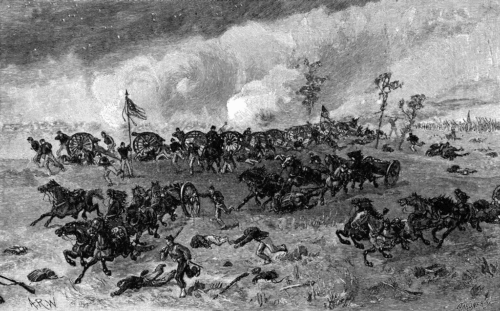
Committed to War: The First Battle of Bull Run
Although Union and Confederate forces had traded shots in some small skirmishes after Abraham Lincoln’s inauguration in March and engaged in a more serious fight over Ft. Sumter in April 1861, it was not until 21 July 1861 that two proper armies clashed in what was the first true battle of the war. Referred to as Bull Run by the Union (whose norm was to name battles after nearby waterways) and as Manassas by the Confederacy (whose norm it was to identify battles by the nearest town) this one-day fight was, to that point in history, the largest battle in the Western Hemisphere. It would be quickly eclipsed by other, larger, battles soon to come, but the issues of scope and scale are important when considering how this battle developed, ended, and what it meant in the context of the war.
After the loss of Ft. Sumter to Confederate aggression in April, the Lincoln administration came under increasing pressure to topple the rogue Confederacy. Marching directly on Richmond, Virginia, the Confederate capitol, was seen as the most obvious means by which to decapitate and thus disable the South, and confidence was high among many civilians and new soldiers and officers that it could be done quickly. On the Southern side of the line, Confederate forces, seeing the same maps, roads, and topography that the Union was studying, began arranging their defenses to counter such an obvious move.
Irvin McDowell, a Union officer who had caught the attention of Secretary of the Treasury Salmon P. Chase, was promoted three ranks to Brigadier General, and was put in command of the Army of Northeastern Virginia – the Union forces in and around Washington, D.C. – on 27 May. Rapid promotions and the skipping of ranks has occurred in all of America’s larger wars, when a sudden expansion of the military – especially the Army – necessitated more officers in a very short period of time. For example, Dwight Eisenhower was promoted three times in a 16-month period at the beginning of World War II, going from Colonel to Lieutenant General. For the Union in 1861, the fact that so many Army officers had betrayed their oaths and signed on with the Confederacy only added to this problem.
Gathering upwards of 36,000 troops, McDowell began establishing training and operational norms, and working out his connections with his subordinate commanders. The Army, made up of five divisions of roughly 7,000 troops each, was a complex machine with nearly endless moving parts and needs: individual soldiers needed to be clothed, fed, armed, and trained. Unit commanders needed to be briefed on their responsibilities and had to draw up plans for training and, eventually, leading their men in combat. McDowell, a capable staff officer, had little prior operational – that is, battlefield – command. In fact, however, no one in the Union Army – or the Confederate forces, for that matter – had commanded such a large force. Beyond what they had learned from reading histories and studying the Napoleonic Wars, no one in America knew how to lead an army of such size. By comparison, American and French forces at the Battle of Yorktown totaled around 18,000 troops, arrayed against about 10,000 British soldiers. McDowell’s force alone was roughly 30% larger.
Bowing to political pressure, McDowell moved his largely untrained, consequently slow-moving army toward the southwest on 16 July, seeking to use the larger portion of his army to attack the Confederates around Bull Run Creek, near Manassas, Virginia, while sending a smaller force around the Confederate right (west) flank to cut them off from retreating and cut the rail lines that led to Richmond.
Meanwhile, P.G.T. Beauregard, who had led Southern forces in the attack on Ft. Sumter, had under his command some 32,000 troops, about 2/3 of whom were in the vicinity of Manassas Junction. Beauregard faced many of the same challenges as McDowell; however, he had successfully led troops in the Mexican-American War, whereas his Union counterpart had been an aide-de-camp to a general during that earlier conflict.
The largest portion of the battle took place in the fields and gently rolling hills around Henry House Hill, which today is the centerpiece to the battlefield park. Both armies exhibited the confused and halting movements and actions of inexperienced troops and leaders, and several thousand troops on each side did not engage in the battle at all, some because they were positioned far from where the action ended up taking place. In broad terms, the battle was a microcosm of the war to come. Civilians had their homes commandeered and in some cases destroyed. Some civilians were caught in the crossfire and killed. A number of officers who would rise to fame during the war and history were involved: Thomas “Stonewall” Jackson, Jubal Early, and James Longstreet for the South, and William T. Sherman and Ambrose Burnside for the Union. The battle itself was a back-and-forth affair for most of the day before Confederate reinforcements arrived by rail – a first in history – but the resulting Confederate victory was more a function of Union disorganization and Southern positioning rather than of a decisive blow from the South. Union forces, by late afternoon, collapsed and retreated in disorder, some all the way back to Washington, D.C. But Beauregard was unable to pursue and destroy the Union army, given how spread out, tired, and disorganized his own forces were by day’s end.
As has been said many times, the First Battle of Bull Run demonstrated foremost the reality that this war was not going to be a short one, so long as the South insisted on secession and the Union insisted on bringing the Southern states back into the constitutional fold. It gave Americans on both sides of the divide a dose of the horrors that would come over the next few years, and planted the seeds for the rise of some officers at the expense of others. It gave the South a morale boost, seemingly validating their choice to secede, and affirming their confidence in their skill, daring, and the righteousness of their cause. It left the North with a bloody nose and a sense of surprise when what they thought was a house of cards turned out to be quite substantial, at least militarily.



